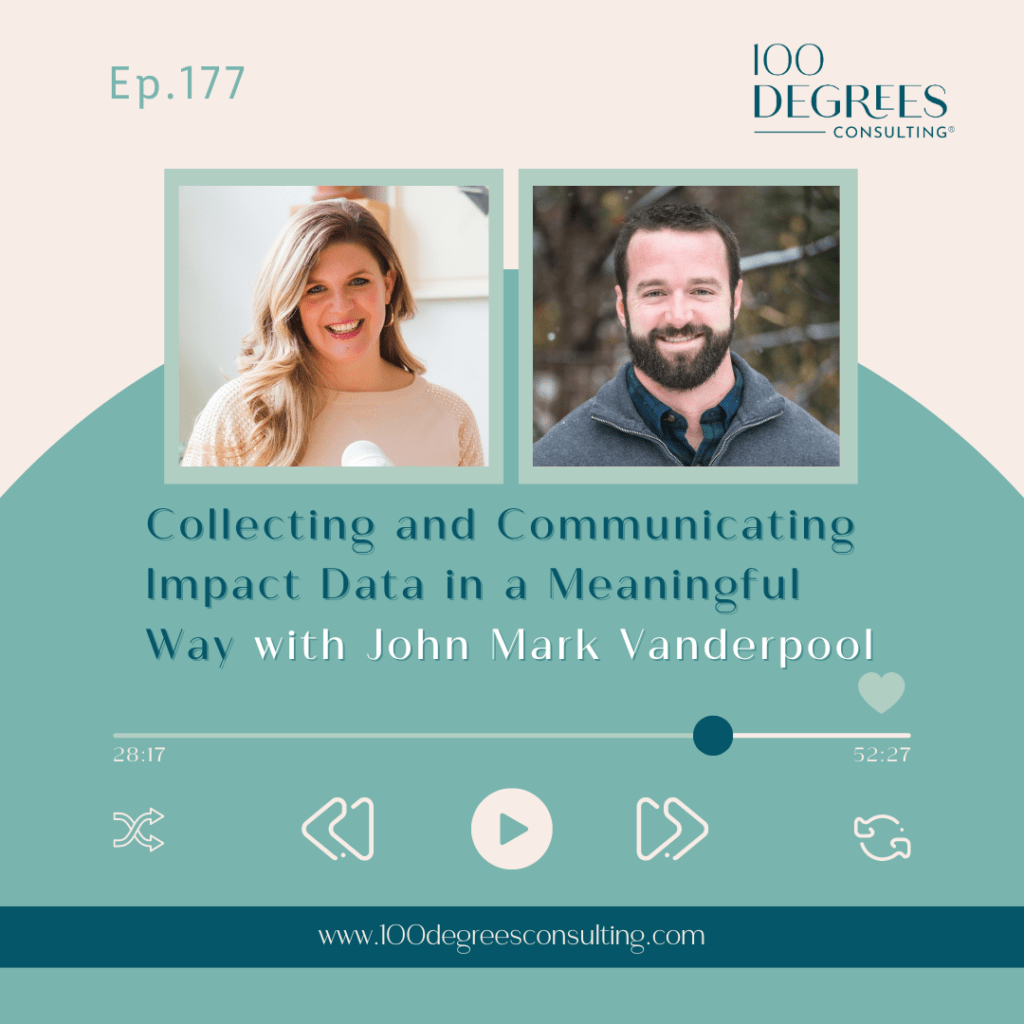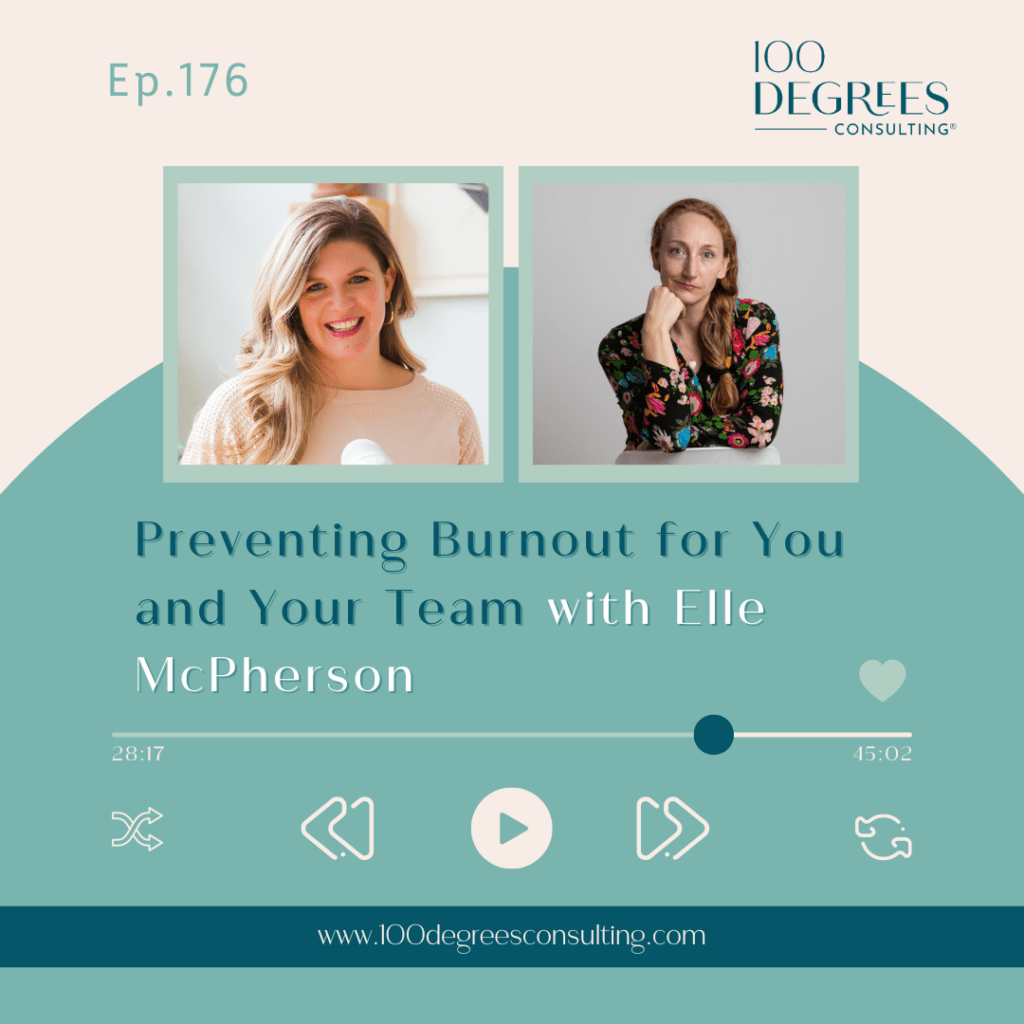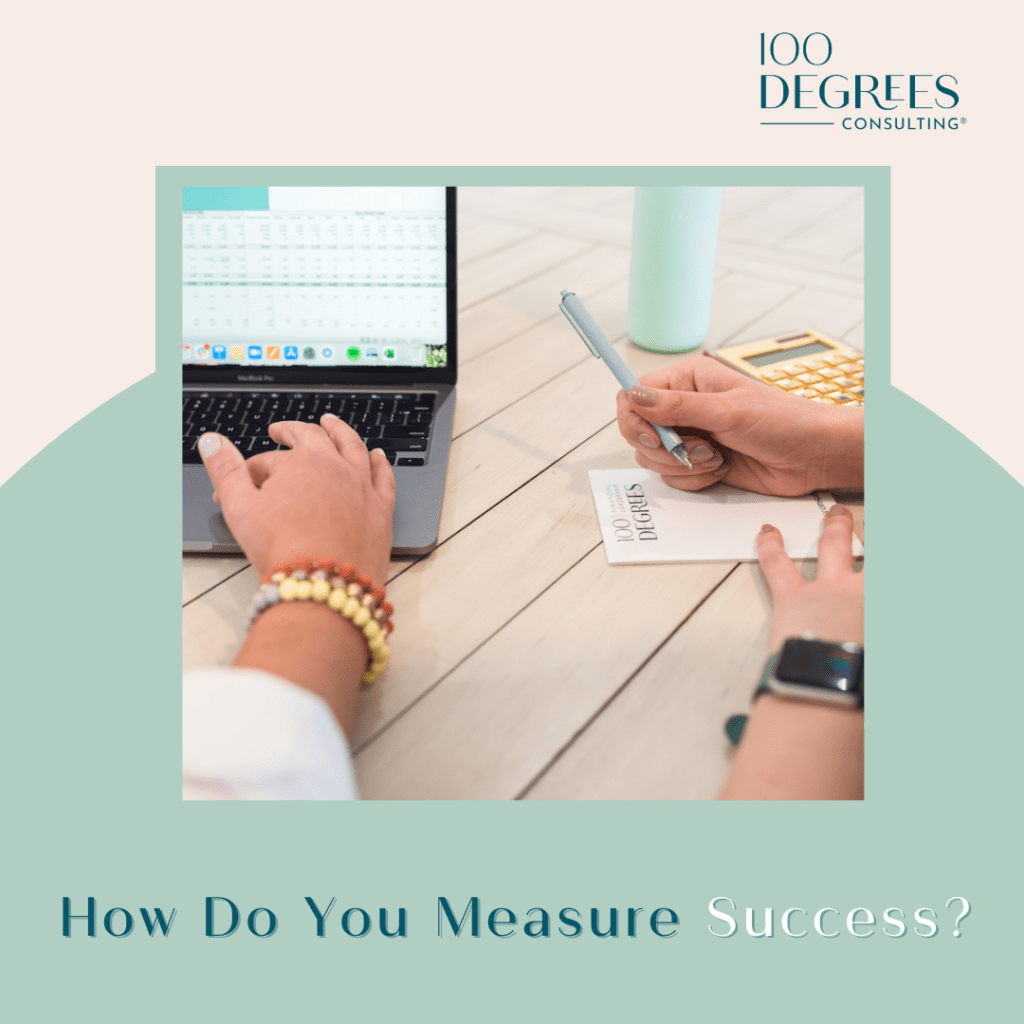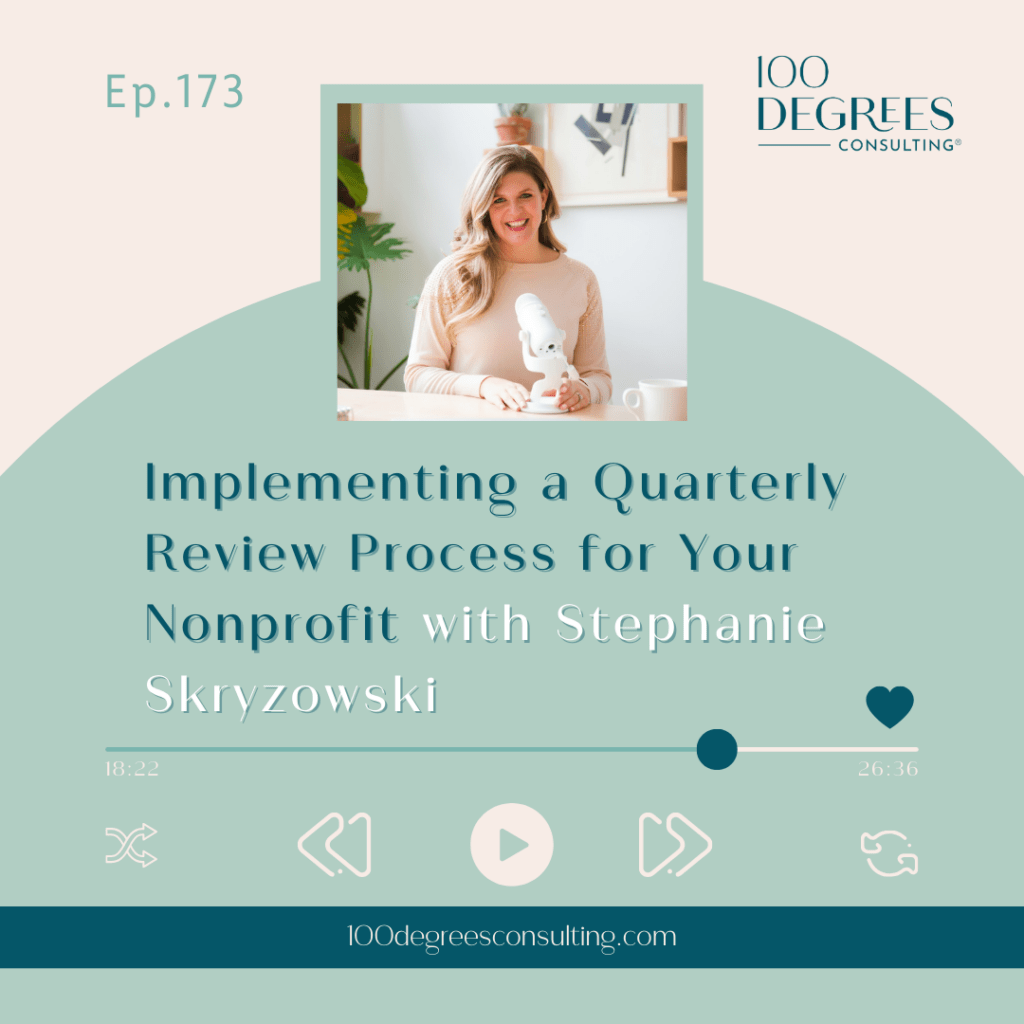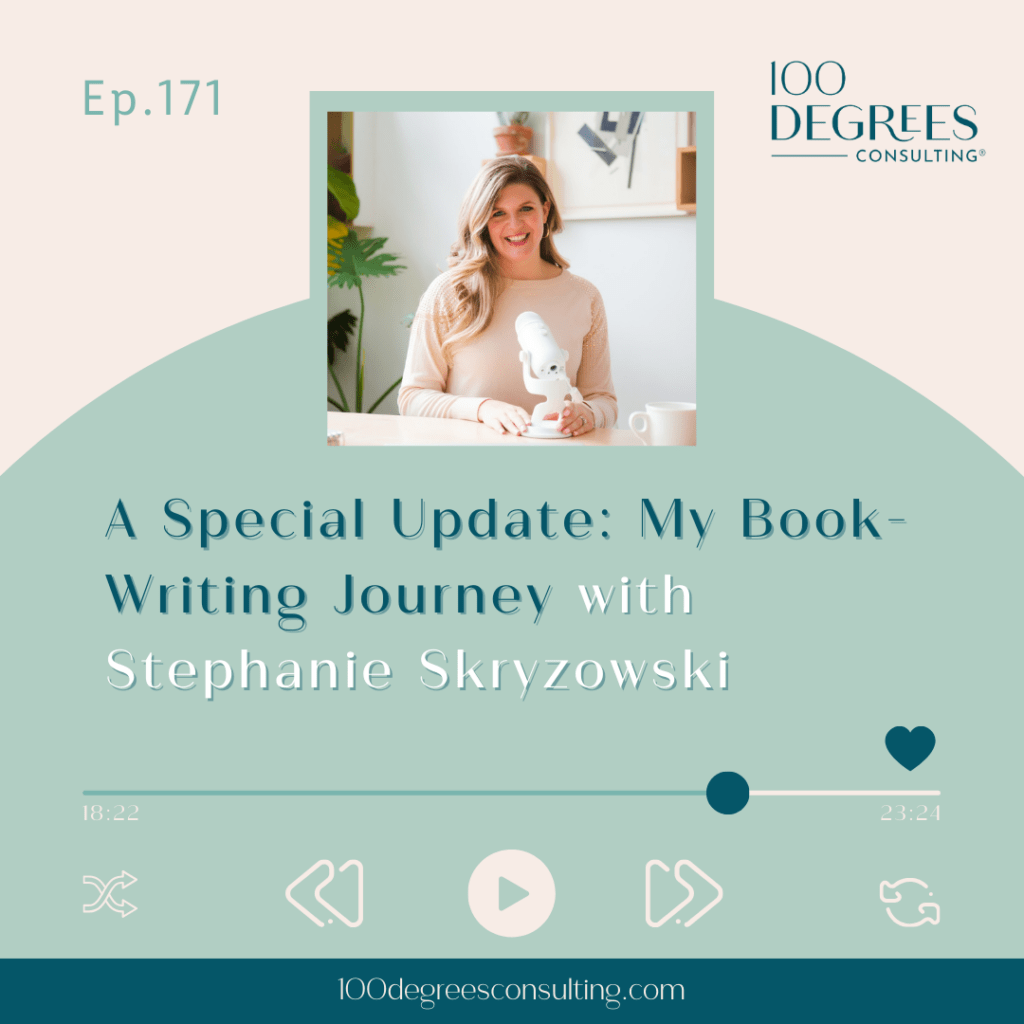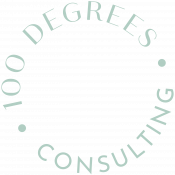Episode 31: How Nonprofit Can Build a Strong Fundraising Culture with Elizabeth Abel
Transcript Episode 31
Stephanie Skryzowski
Welcome to the 100 Degrees of Entrepreneurship Podcast, the show for purpose-driven entrepreneurs who want to get inspired to step outside of your comfort zone, expand it to your purpose and grow your business in a big way.
I’m your host, Stephanie Skryzowski, a globe trotting CFO whose mission is to empower leaders to better understand their numbers to grow their impact and their income. Let’s dive in!
Welcome back to the 100 degrees of entrepreneurship podcast. I’m really excited to chat with my guest today, Elizabeth Abel. Elizabeth, welcome!
Elizabeth Abel
Hello, thank you so much, Stephanie. Really thrilled to be here!
Stephanie Skryzowski
So, we’re doing something a little bit different today. We’ve talked a lot about like building businesses and entrepreneurship. And Elizabeth is actually like a nonprofit expert, and a fundraising consultant and is really, really well-versed in nonprofit philanthropy and that whole world. So we’re kind of changing things up today, but I’m really excited to talk to you. So why don’t you kind of share with us a little bit about what you do now. And then, the journey that led from wherever you started to what you’re doing now?
Elizabeth Abel
I would be happy to. So, I am an executive at a firm called CCS Fundraising. CCS is a global fundraising consulting firm that partners exclusively with nonprofits to elevate their fundraising programs.
So what does this mean? We work with organizations that are embarking on capital or endowment campaigns. We do feasibility and planning studies to prepare organizations for large scale fundraising efforts. And we work with board members and volunteer leaders to help them champion their role as fundraising ambassadors.
I’ve been with the firm for about eight years, and I’ve been in philanthropy now for close to a decade. And I absolutely love the work! When I think back to, you know, a decade prior and where I was, in my career, had I known that I would be where I am now, I think I would have been more excited than I am now, because of the work that philanthropy does and driving really meaningful and sustainable social change.
And so that’s been my own impetus for becoming involved in fundraising consulting, working with nonprofits, because I believe that they’re addressing some of the most important social issues of our time. And the way that they can do that – the gas in their engine is philanthropy and charitable gifts. And so it’s such a privilege to be here to share a little bit more about what I do and what philanthropy does for nonprofits who are really changing the world.
Stephanie Skryzowski
I love that because I talk all the time, even to our small business clients about how money creates impact. And you’re dealing with this on a day to day basis on a very large scale on massive capital and fundraising campaigns. And so billions of dollars are making a huge impact. I just love that tie that you made. And it’s just such a good reminder to even the smaller organizations out there, either nonprofits or just a small business, the more money that you have, the greater impact that you can make. So when you graduated college or even younger than that, did you think you wanted to go into the philanthropy space? Or was that always a goal of yours? or How did you land there?
Elizabeth Abel
My background has actually been in the Jewish community. My focus has always been on Holocaust and genocide education. It’s an issue that’s affected my family and as I’ve grown and have learned more about my family’s history, our own personal story and narrative has really influenced my own career trajectory and experiences that I’ve had. And kind of coupling with that when I was in college, I studied International Relations and Peace and Justice Studies.
And the Peace and Justice Studies brought me to India where I worked with women focusing on generational empowerment, specifically access to education, the impact of the dowry system, and other aspects of their life. And then I also spend some time in Rwanda, where I volunteered at a youth village that was founded to provide a loving safe home for teenage orphans of the 1994 genocide. And throughout these experiences, I had the opportunity to meet people whose stories of strength and resilience have stayed with me to this day. And when I thought about what it is that I want to do, what can I apply my skills and energy to, I just kept coming back to the nonprofit sector, because of this unwavering focus on social justice and social change.
I happen to be a very type A personality. And so for me figuring out the balance between what’s the right cultural fit for a career, while still working in a community that has shared values, I ended up finding my way into fundraising consulting, and so it’s a great balance between working with mission driven organizations and also having this 30,000 foot strategy, that you can then partner with organizations to implement. And so it’s just been an awesome balance. And it’s been exciting to see the ways in which we can work together with nonprofit executives and fundraisers, to think about their goals and their vision for the future and then build out strategic action-oriented plan that we then work together to implement, and to be able to see the major gifts that we’ve raised, and the way in which we’ve built infrastructure around fundraising and systems and processes that will allow these organizations to thrive in the future while building on a sustainable fundraising platform has been really meaningful.
Stephanie Skryzowski
Yeah, that’s really interesting that that has sort of always been your path. I feel like, a lot of times, we start as thinking we’re gonna do one thing, I thought I was going to be a lawyer in corporate America. And then we end up doing something wildly different, actually, I was just talking to somebody else. And their path also kind of remained, you know, it was winding but it still sort of remained consistent. So I love that. And I think that really gives your work a lot of purpose that, like what you’re doing is actually something that is personally meaningful to you and to your family. And I love that.
So the nonprofit philanthropic landscape right now, I imagine that in the course of your career over the last 10 years, lots of things have shifted from sort of general priorities to all of the different things going on in the world. So what is the philanthropic landscape, right now, look like for nonprofits?
Elizabeth Abel
When we look at 2020 and 2021, I think what we can really say with confidence is that the philanthropic landscape is one of resiliency, responsiveness and continued evolution. And if 2020 taught us one thing, it’s the importance of really being nimble and innovative. And at the same time building and maintaining authentic relationships with our donors, our leaders, and our teams.
And when I look to the future, I feel optimistic. In 2020, we saw a record breaking $471.44 billion that was invested in the philanthropic marketplace. That’s more than I thought we were going to see, given the pretty devastating impact of COVID, the country’s reckoning with racial and social injustice, the election, I was not feeling optimistic in the beginning of 2020, about the state of philanthropy, and to see the strength and resiliency of Americans, and our generosity and the causes and communities that we care about. I feel like we’re looking ahead from a place of strength, while also recognizing that there are some real issues we are grappling with as a nation.
Stephanie Skryzowski
Yeah, you’re right. It is so interesting, in the midst of a global pandemic, and everything else that happened in 2020, seeing that record breaking number. So what does that mean for smaller organizations? I know we work with a lot of small to midsize organizations, was that investment into nonprofits in the US? Was that sort of equitably spread out amongst all different sizes of nonprofits? Or are they like the big ones? Did they receive the lion’s share of that? or what have you seen in terms of the impact for those smaller orgs?
Elizabeth Abel
So what we’re seeing based on sector, is that most sectors did receive an infusion of philanthropy that was greater in 2020, than it was in 2019. We thought educational institutions received the most as well as religious organizations. We saw a huge rise in advocacy and human and social services organizations.
Unfortunately, organizations in the arts, museums, theaters, arts and cultural institutions took a hit because so much of their work is in-person revenue generating activity. But at the end of the day, I would say there’s really three things that organizations can do to put their strongest foot forward as we look ahead. And I think that first is really about how they’re communicating their mission and their case for philanthropic support to their community and their funders, and making sure that we’re really articulating the relevancy of the work that we’re doing right now. And at the same time, the impact that philanthropic investments can have on our community. So it’s not just you know, “Stephanie, you should invest in my organization, but you should invest in it because you can be a part of the future and it’s relevant now. And here’s why.” And so it’s making people feel like they’re insiders, and that their dollars can really change the landscape. I don’t know if that resonates with you, if that’s what you’ve seen, kind of in your business hat, but how you’re communicating and effectively selling your mission to potential investors.
Stephanie Skryzowski
Yeah, I think you’re so right. And I feel like I’ve been parts of conversations. Oh, for the years that have talked about storytelling and in nonprofit specifically, and I think about that a lot, because I do a talk called, “Storytelling with Financials,” and talking about really how to use your financial statements, your numbers, to tell a more robust story about your organization.
But I feel like the word storytelling is kind of thrown around a lot. It’s like the newest buzzword basically. So, how do organizations kind of leverage storytelling to inspire, giving instead of just saying, like, donate now donate $20, whatever, how do organizations like practically do that?
Elizabeth Abel
It’s such a great question. And it’s one we really grapple with all the time. You know, if I’m a food bank, do I talk about the 20,000 families that we serve? Or do I share the experience of this one six year old boy whose life was changed, because he was able to have a meal every day and what the benefits were for him and his family. And what we’re actually seeing is it’s that one story. And so as a donor, what I want to see is how my philanthropy can impact a person, another human being, and can help elevate them and their family. And so yes, the statistics are so powerful and very compelling. But it’s important to weave those in with personal stories of demonstrated impact.
And so I would say, you know, I’m working with an organization right now, we’re doing visioning sessions with their leaders for a very large scale campaign. And part of what we’re doing is to help identify these big ideas that donors will feel inspired to invest in. And I was on a call earlier this week, with a woman who was sharing her story for why she works at this organization. And she starts to share the story about how she lost her son earlier this year to cancer. And I was just thinking to myself, how powerful her story was for why she was working at this organization, despite the fact that she’s had what I truly cannot imagine to have happened. And I was thinking about my own daughter. And if I were a donor, I would just be like, “Here is my wallet!” to make the change that you want to see in the world.
But it really got me thinking, after the call, about the power of a single human story and a single human life that philanthropy can touch, and how we can communicate that to donors in a way that makes them feel like they’re really making a difference, and actually does.
Stephanie Skryzowski
You’re right. And I think that any books that you read on marketing are all talking about storytelling and making that like human to human connection. And I agree, I’m actually reading a book right now called, “Stories That Stick.”
Elizabeth Abel
I’m gonna have to write this down.
Stephanie Skryzowski
Yeah, it’s a really good one. And she talks about, like the four different kinds of stories, and it applies to businesses, it applies to nonprofits. And she was in one particular fundraising event where they, you know, had had sort of dismal results. And then they put people up on the stage that told a story that related to the organization’s mission. And people were just like, you said, like, “Here’s my credit card, take my money, like, this is amazing! We want to be part of this!” So yeah, I think that storytelling is so important.
And do you have any tips for leaders in drawing those stories out? I will say like little plug for this book, and I have nothing to do with this book. I’m just reading it, but she talks about how to like, get story ideas, but are there anything that you work with your clients on? helping them figure out like how to pull those stories out? What type of stories do we want to tell? Do you have any tips on that?
Elizabeth Abel
I do. And you said stories that stick? Is that? The title?
Stephanie Skryzowski
Yes. Stories That Stick by Kindra Hall. It’s really good!
Elizabeth Abel
I’m writing this down. Yeah. Hopefully that title sticks with me.
Stephanie Skryzowski
Yeah.
Elizabeth Abel
So yes, one of the things that we do often with organizations that are thinking about embarking on a significant fundraising endeavor, before they start their campaign, before they start their planning study to test their campaign vision, and message with potential funders, we actually do what’s called a visioning session, which is essentially an opportunity to bring leaders across all areas of the organization – executive, administrative, programmatic, operational – and have a conversation about what are the organization’s strengths, challenges, the value proposition? When we look 5, 10, 20 years ahead, what do we want the headlines to be about this organization? Let’s work backwards now and see how philanthropy can help get us there.
And it’s just a really exciting and inspiring way to generate big ideas that will galvanize momentum around the mission, inspire, support, and ultimately create this cohesive narrative that we can build a philanthropic case around.
Stephanie Skryzowski
Yeah, I think that’s great. So one thing that I’ve experienced a lot in a number of different nonprofit organizations is that the finance team were sort of like the hub of a wheel. And then there’s like all the little spokes, or all the different departments, and everybody talks to finance. But I feel like sometimes it’s not necessarily a super collaborative interaction. And so one thing that I’ve always worked to do is really open up those doors for communication between finance and fundraising, especially, there’s just so much overlap there and interaction and forecasting, and really making sure that the finance team and the fundraising team are on the same page.
And I imagine that within the fundraising team, there’s a whole culture that you can really build there. And I have seen in different organizations, the programs, I feel like everybody in the nonprofit can really easily get burned out, because we’re all doing so much all the time. And not only are we putting our day to day efforts into the work, but also like our heart and soul is pouring into everything that we’re doing. So we’re all kind of burnt out to a degree. But I feel like there’s a lot of pressure on the fundraising team to like, bring in the money to be able to fund the mission. And so I feel like a team culture and the systems and processes and the way that you all work together, and the way that you work with the organization is particularly important in that department. And so what have you seen that really works for nonprofits to build a really strong fundraising team and culture within that?
Elizabeth Abel
This is such an important point. And I am so glad you brought this up. I was literally having a conversation with two colleagues earlier today about this exact topic. And so I would say there’s two things, it’s kind of inputs and outputs, right? So we start with finance, who more often than not, is driving the annual fundraising goal setting process for the organization. And what I would say to this point is that it really should be a collaborative process between finance and development.
Oftentimes, the development office will meet at school, and then the congratulatory response is “Great, let’s increase it by X percent for next year!” And we don’t necessarily know, is there a pipeline to reach that new goal? Do we have the donors already engaged who will sustain or increase their gifts? Do we have the leaders who will help the multipliers in generating that revenue? And so I think it’s so, so important to bring everyone to the table and have an integrated process or financial goal setting. So I think that’s part one.
And then Part two is once you think about it as a circle, right? So we start with finance, we go to development, then we’re gonna go back to finance. So now we’re at part two, where we’re at development, we’ve raised the revenue, and the question development often has is, “Where’s the revenue going? My donors want to know,” okay, I gave you a 10,000 or $100,000. donor, where did the money go? And so I think it’s so important that finance and fundraising teams are communicating about where the money’s going once it’s been raised, because that’s something that we see a lot too, right? It’s finance sets the goal, advancement meets the goals. And then advancement says “hey finance where’d the money go?” And oftentimes, you’re then working backwards, because we were not thinking ahead to reporting to donors. And so I think it’s so important that our finance teams, our development teams, and oftentimes our executive leadership are talking regularly and really collaborating around our revenue strategies and reporting to make sure that everyone’s on the same page.
Stephanie Skryzowski
Yes, that’s such a good point. And I definitely have advocated in different organizations that I’ve worked with that like finance, and you know, the CEO, or executive director or leadership, whoever needs to not set the fundraising goals without the development team as part of that, because like you said, it’s like, okay, we raised this much last year at let’s just add 20%. And the fundraising seems like wait a second, like, we don’t know where that 20% is coming from. So I love that. And I like that you kind of illustrated this sort of like circular, or cyclical process where you’re right, once the money is in as the finance people, we need to make sure that we have set up our systems to be able to track things the way that you’d then need to report out back to your donors. And so that’s always been a part of our process is really understanding. “Okay, what money do we have coming in and from what different forms, whether it’s individual donations or government grants or foundation gifts, whatever that might be. And how do we then need to report back out on that because we want to make sure our systems are set up to do that well,” and so in an ideal situation for on the finance side, it’s just like the click of a button and here’s the report that you need to give to your donor or here’s the analysis that you need to show them how we’re spending our money on like, worst case situation, there’s a lot of finagling in Excel. Like we don’t want to be doing that!
Elizabeth Abel
I hate finagling and Excel.
Stephanie Skryzowski
Yes, there’s been a lot of that.
Elizabeth Abel
There’s so much of it.
Stephanie Skryzowski
Yes, exactly. So I love that you kind of pulled those two together. And I just remember working in an organization where it was just constant growth. And the fundraising team was like, “We don’t know how we’re going to do this. This needs to be more of a collaborative conversation.” So I think those are great tips.
***Commercial Break***
One of the most frequent questions I hear is, “What’s the difference between a CFO, a bookkeeper and accountant? And which one do I actually need in my business?” So I have created a quiz to help you figure out just that, pop on over to 100degreesconsulting.com/quiz, answer just a couple questions about your money management style and your business. And we will tell you exactly the right person that you need to help you manage your business money. Again, 100degreesconsulting.com/quiz!
Stephanie Skryzowski
What about smaller organizations that maybe don’t have a full development team? Like what should they be thinking about as they’re starting to build a fundraising culture in their organization, but maybe don’t have a team of fundraisers yet?
Elizabeth Abel
I think one of the ways in which smaller nonprofit organizations can scale their fundraising activity is by leveraging their volunteer leadership, specifically, their board members. So if you’re a one or two, or even three person, fundraising team, but you have an 8, 10, 12 person board, are there two or three people on your board that are champions of your mission and are comfortable soliciting others that you could work with and perhaps provide a brief solicitation training, provide them with talking points so that they can effectively be multipliers of your office? We’ve seen that work really well, particularly with smaller organizations that are seeking to scale their programs and services, and don’t yet have the teams in place to implement larger scale programs. So it’s kind of that stepping stone. So I think really leveraging your volunteer leaders as your fundraising ambassadors is one of the greatest assets and ways in which nonprofits can fundraise without having to hire professional staff, should that not be in their budget.
Stephanie Skryzowski
Yeah, I think that’s a great tip. And something that I’ve seen done very successfully in many organizations. But it’s also been like pulling teeth in other organizations. So it can be very challenging. And so, are there anything in your consulting work as you’re encouraging boards to mobilize and contribute to the fundraising effort? Is there anything that organizations can do? Is there training that they can provide or other things they can get the board involved in to help sort of stimulate that fundraising?
Elizabeth Abel
Yeah, so we work with organizations to do just that. We provide fundraising training workshops, and solicitation trainings for board members and volunteers. And I have to be honest, it is one of my favorite things. It’s so exciting to walk into a room with 15 people who are not interested in fundraising, and then an hour later, watch their body language change, their confidence build, and there’s a sense of energy around, “I can do this, I can invite people to make a gift. I’m not asking them for money. I’m inviting them to be a part of an organization that’s making real change.” And I think, so much of it is a mindset issue. We’re just changing the way we’re thinking about fundraising to be less. “Stephanie, can you invest in this organization where I sit on the board?” To “Stephanie, I’m involved in this amazing organization, it’s changing lives. Here’s some of our impact statements and the work that we do and would love to tell you a bit more about it. Would you be interested in investing in this cause and, and investing in the families that we’re serving.” And the message, the narrative, it shifts – it shifts to kind of a transactional request to one that’s grounded in an authentic relationship with a vision of social change.
Stephanie Skryzowski
I love that so much. And I just even kind of thought about that in terms of business in terms of my business. And in terms of anybody who’s running a business and sort of selling something, instead of just asking someone to buy your thing, whatever it might be, your course, or your program or your product. It’s inviting them to be part of some type of experience. I love how that is applicable to nonprofits too. It’s like, yeah, we’re not just asking for you to give us money and like, “oh, sorry, can you just give me money for this little nonprofit?” It’s like, “hey, I want you to be part of this movement that’s happening. And here’s how you can do that.” So I love that shift. And I imagine for you, that’s pretty rewarding. Being able to see a room of people sort of transform from like, “I don’t want to ask anybody for money,” to being like, “Oh my gosh, I want to tell everyone about this. This is so exciting.” Yeah, I imagine that must be pretty rewarding.
Elizabeth Abel
It is. I also teach a course at the University of Pennsylvania. fundraising course for graduate students in the school’s nonprofit leadership program and a similar experience, they have about 20 to 25 students each spring and many of them work in the nonprofit sector, but many of them are not fundraisers. Their executive leadership, their programmatic leaders and executive leadership, I believe is also a frontline fundraiser, but sometimes it’s not necessarily the case. It’s really exciting. There’s always a couple of students each year who are very open that they’re taking this class because they’re not comfortable fundraising, they recognize it’s a part of their role, but they don’t like it, they don’t know how to do it, and to see the transformation over a semester, the enthusiasm, the confidence, and then, you know, circling back with those students 6, 12, 18 months later, when they share these really extraordinary gifts that they solicited. It reminds me why I do the work that I do, this idea of educating and empowering nonprofit leaders and professionals with the knowledge and tools to elevate philanthropy, that’s kind of my own personal mission and reason for why I do the work that I do and, and to think about the change and the impact that each one of these students each one of these board members can have. And they feel prepared and confident. It’s where I get my energy every day.
Stephanie Skryzowski
Yeah. I love that. How did you get started teaching at the University of Pennsylvania? That’s pretty cool to teach a graduate level course, how did you get started doing that?
Elizabeth Abel
Thank you, thank you. So it’s where I got my master’s degree in nonprofit leadership. And I happened to take a fundraising course taught by Eileen Heisman, who’s the CEO of the National Philanthropic Trust, and she is a powerhouse in philanthropy. And really, the reason why I made the pivot into fundraising consulting her class was my “aha moment” over the semester, and I was invited to serve on the Alumni Association Board. And one thing led to another, Eileen and I have been co-teaching for a couple of years. And it’s just been such a privilege both to continue to learn from her and collaborate with her. And it’s been a wonderfully fulfilling and engaging experience. So very happy to be involved.
Stephanie Skryzowski
Yeah. Are you ever sort of out of your comfort zone? Like, “I graduated from this school? And now I’m like teaching here?” Did you ever get any of that imposter syndrome? Or were you always like, “No, I’m good. This is great. This is where I want to be.”
Elizabeth Abel
It’s a great question. And it’s one that I’ve thought a lot about, not just through my work. But really, throughout my career, I am younger than many of my contemporaries. You can’t see it on Zoom, but I’m literally five feet tall. And so I think the combination has been something that quite, honestly, I’ve been insecure about, for the first half of my career, you know, I will walk into a boardroom with some of the biggest philanthropists in the country. And I felt like, “Should I really be here? I’m going to be the one telling them how to fundraise on behalf of this organization.”
And I had a defining moment, several years ago, kind of earlier on when I had first started, I was conducting planning, study interviews for an organization. And in my role as a consultant, I interview philanthropists and kind of share their perceptions of the organization and get a sense of their appetite for a campaign. And I was interviewing, interestingly enough, a woman, an older woman who walked into the room, looked me up and down and said, “Well, you’re exactly like I was told you, and you’re quite young. But I hear you’re also competent.” And I just remember, I froze, I was like, “how do I even begin to respond to this?” but it really struck a chord in me because she just pinpointed my insecurity, right? Like, at the time I was in my mid-20s. Like I, again, very petite, I looked young. And it really rocked my confidence for quite some time. And it wasn’t until fairly recently, where I now actually shifted my own mindset and believe that my age is my greatest advantage. And for me, that changed my confidence. It changed how I enter a room, it changed how I speak to important philanthropists, and communicate my own message and why I do the work that I do. And I’m grateful for that experience that I had, because it really grounded me and why am I here? Why am I continuing the work that I do? Like, I soaked it in, the comment, it sucked. But at the same time, it really made me stronger. And so I think my message is, you know, what is our own greatest insecurity? And how can we shift our mindset so that our greatest insecurities are actually our greatest advantage.
Stephanie Skryzowski
Oh, my goodness! Wow, I love that so much. Because first of all, I can’t even imagine like, how do you even respond to that? That sounds like inappropriate for that person to said, but then yeah, I can see how that would totally just shake you because she called to light the things that you were already feeling inside. And you’re like, well, at least this is how I would interpret it. Well, I was already feeling it, she just said it out loud. So it must be true. So I can totally imagine how that must have shook you. But I like how you flip that around. So I think that’s just a good reminder to anybody listening, if you do have some really big insecurities, even if they are something that has been publicly called out in a super inappropriate way, there’s a way to turn that around, and to turn that into your biggest asset. So I love that and I appreciate you telling that story. I was really interested to hear about the teaching and kind of how you got into that. So I appreciate that. Awesome.
Well, I like to end our episodes with just a few quick questions. Because what happens is, I usually get some really good ideas for my own personal reading list. We’ll talk about that in a second and other things I can do to increase productivity in my life. So this is like a little bit of a selfish move. But I love hearing everybody’s answers to these questions. So my first question is, what is your favorite productivity hack or tip in your business or your life? And I know you’re also balancing a lot, you have a little one at home. So what’s your favorite productivity tip?
Elizabeth Abel
I live by my color coded calendar, I cannot function without it. And my productivity tip is to manage your time by your calendar, and to work backwards from your goals. So if you have deliverables that are due September 1, what do you need to do between now and September 1, to do them, to do them well, and to give yourself buffer time for the things that will inevitably come up. So my hack is always to look ahead, work backwards, and to leverage your calendar as your tool to do so.
Stephanie Skryzowski
I love that somebody else was just telling me this morning that they use Google Calendar and they use the tasks in the Google calendar to map out their to-do lists and kind of place it on the calendar, which I thought was kind of fun. And I have not used tasks and Google Calendar before.
Elizabeth Abel
I haven’t either. But I also I’m old fashion I get such satisfaction out of like striking the pen. All of my to do list and that item that has been staring me down for several days, the pleasure that I get just crossing it off. Brings me more joy that is probably appropriate.
Stephanie Skryzowski
I know I’m with you. I have my to do list right here and then I crossed it off with a sharpie. That’s like extra…
Elizabeth Abel
Oooh!! That is a powerful cross!
Stephanie Skryzowski
Exactly. Okay, my next question is, what is the favorite book that you’ve read, I will say most of our responses are usually a nonfiction book, but I will say beyond that any genre favorite book you’ve read.
Elizabeth Abel
So I don’t know if it’s necessarily my favorite. But it is the book that I’m talking about every day whenever someone asks me what is on my nightstand, and it is Digital Body Language by Erica Dhawan, who’s a leadership and management expert. And it’s all about the ways in which we are communicating with one another and building relationships with one another in this digital world. And I just think it really needs a moment. It provides really practical, action oriented tips for how we are communicating via email, how we’re leaving virtual meetings, how we are texting, G-chatting, Teams-ing one another. And it might seem so simple, but it’s actually really incredible how often our communications can be misinterpreted in this digital world, our body language can be misinterpreted. So for me it really grounded me in best practices on digital communication as a leader, as a manager, as a consultant, a fundraiser, etc. So I could not recommend it more. It’s really, really quick read but really, really tangible.
Stephanie Skryzowski
Oh, I love that. So as you were talking, I just pulled it up. So I could like visualize it. And already the description of it. I’m like, I need to read this. That sounds great. Okay, I also use this question as like making my personal reading list. So thank you for that.
Elizabeth Abel
No, it’s great.
Stephanie Skryzowski
I haven’t heard of this one before.
Elizabeth Abel
Well, I’ve given you one and you’ve given me one. So I feel like we’re gonna have to have a little book club here.
Stephanie Skryzowski
Exactly. Yes. Oh my gosh, that’s a great idea. Love it. Okay, this is on my list now. Okay. And my last question is, imagine that you had a week day, completely free from work from obligations from any like, must dues. What do you do?
Elizabeth Abel
Oh, my gosh, that idea is so foreign.
Stephanie Skryzowski
I know, right?
Elizabeth Abel
Especially ever since having a baby. Just the idea of having time to myself feels like that’s not a thing anymore. That is such a great question. So I would probably take a yoga class, have a cup of tea, and go to the Metropolitan Museum of Art with a visit to the Impressionists section. That would probably be my dream personal day, just really grounding myself doing something that brings me energy and most importantly gets me out of the apartment.
Stephanie Skryzowski
Yes, that sounds like a dream. And yes, Elizabeth lives in New York City. So that’s the context for that. I love that. That sounds like a beautiful day. If I’m asking the question to a parent, they’re usually like, “Wait, do I have the kids? Or do I not have the kids?” I’m like, “Let’s say you don’t have the kids.” They’re like, “Okay, well, now let me tell you.”
Elizabeth Abel
I know the kids, it would take just work for me right now, just one, but it would take 45 minutes just to get out of the apartment. I don’t even know if you’d make it the 20 blocks to the Metropolitan Museum of Art. So I’m pretending that she’s on her own now.
Stephanie Skryzowski
All right. Well, Elizabeth, it was such a joy to talk to you today. Thank you so much for your time and for sharing everything you did about fundraising and the nonprofit world. And I feel like our listeners, even if you are a small business owner, or an entrepreneur, there are so many gems that you can pull out of this that are applicable to you, too. So Elizabeth, thank you so much for your time. I am grateful.
Elizabeth Abel
Thank you, Stephanie, I really, really appreciate this conversation and the opportunity to share my insights and perspectives. And if anyone is interested in continuing the conversation, I’m always happy to share more about philanthropy and fundraising consulting, and really just care so deeply about making an impact through charitable giving. So thank you so much for all of your time and for your expertise as well.
Stephanie Skryzowski
Wonderful. And actually, yeah, before we leave, where can our listeners find you?
Elizabeth Abel
So I am quite active on social media. You can find me on Instagram @elizabethberniabel, where I post regular nonprofit industry insights and some action oriented fundraising tips. You can also email me directly at eabel@ccsfundraising.com
Stephanie Skryzowski
Awesome. Thank you so much. Actually, Elizabeth and I met on Instagram, so definitely check her out over there. All right, Elizabeth. Thank you!
Elizabeth Abel
Of course, we’ll talk soon!
Stephanie Skryzowski
Thanks for listening to the 100 degrees of entrepreneurship podcast. To access our show notes and bonus content, visit 100degreesconsulting.com/podcast. Make sure to snap a screenshot on your phone of this episode and tag me on instagram @stephanie.skry and I’ll be sure to share. Thanks for being here friends, and I’ll see you next time!
Transcript Episode 31




